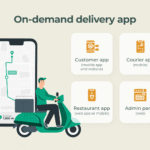Introduction
Read Authentic research shows that on-demand laundry apps have redefined how people manage washing, dry-cleaning, and ironing. Users no longer want to visit laundromats or depend on irregular local services. They expect quick pickups, real-time updates, hygienic processes, transparent pricing, and reliable doorstep delivery. Laundry brands also prefer app-based operations because it improves scheduling, demand forecasting, and customer retention.
This guide explains how to build a dependable, scalable, and profitable on-demand laundry app using verified market insights and proven operational frameworks.
You will learn:
Market insights: Growth drivers behind app-based laundry, consumer behavior, and hygiene expectations.
How laundry apps work: From pickup scheduling to washing, quality checks, and delivery.
Business models: Aggregator, full-stack, marketplace, franchise, and hybrid formats.
Core features: User app, driver app, laundry partner app, and admin system essentials.
Technology stack: Frameworks that support accuracy, speed, and long-term scalability.
Development process: A clear roadmap from MVP to full-scale launch.
Cost breakdown: Verified cost benchmarks across different regions and feature sets.
Revenue models: Per-order commissions, subscriptions, add-on services, and partner promotions.
AI use cases: Smart pickup scheduling, demand forecasting, load distribution, and ETA prediction.
Operational logistics: Fabric handling, batching, routing, and quality control workflows.
Challenges: Pickup delays, fabric damage, partner inconsistencies, and cost leakage with step-by-step solutions.
Case studies: Lessons from leading laundry apps operating at scale.
If you are a startup founder, laundry service brand, or development agency, this verified playbook provides everything you need to build an on-demand laundry app that is fast, efficient, and built for long-term growth.
Understanding the Laundry Service Market
The on-demand laundry market is expanding quickly as users shift from traditional laundromats to app-based services that offer pickup, washing, ironing, and delivery. Urban lifestyles, higher hygiene expectations, and mobile-first behavior make this one of the fastest-growing service segments.
Why the On-Demand Laundry Market Is Growing
Users want fast pickup and delivery without visiting laundromats.
Digital payments and smartphone adoption make app-based laundry simple.
Subscription and scheduled pickup models support consistent recurring demand.
Higher hygiene expectations drive users toward professional laundry care.
Market Size and Growth Data
The global dry-cleaning and laundry services market was valued at USD 78.20 billion in 2024. It is expected to reach USD 118.71 billion by 2030 according to the
For the online segment, the market is projected to grow from USD 94.01 billion (2024) to more than USD 1 trillion by 2032 based on the
Online On-Demand Laundry Service Market Study.
Verified by Read Authentic research, this category continues to grow due to predictable demand and service convenience.
Key Market Segments and Demand Patterns
Service Segments
Wash and fold services remain the most used category, while duvet cleaning and premium care are growing fastest. This is highlighted in the
Application Segments
Residential users dominate the market driven by working professionals, families, and students.
Commercial demand is rising among hotels, hostels, and hospitals, supported by findings in the
Commercial Laundry Services Market Analysis.
Regional Insights
The Asia Pacific region is witnessing the fastest growth due to increasing mobile usage and rising disposable income, confirmed by the
APAC Laundry Market Growth Overview.
North America remains a mature and high-adoption market backed by strong digital infrastructure.
Why This Market Is Attractive for Founders
High reorder frequency and predictable recurring revenue
Operational model is proven and easy to standardize
Partnership opportunities with laundromats and residential complexes
Technology reduces manual overhead and improves delivery accuracy
This market foundation helps you evaluate the growth potential of on-demand laundry platforms and plan your product strategy with confidence.
How On-Demand Laundry Apps Work
On-demand laundry apps follow a structured flow that connects users, drivers, laundry partners, and the admin system. The experience must feel simple for the user, yet the backend must manage dozens of moving parts like pickup timing, washing cycles, partner allocation, and delivery routing.
End-to-End Workflow
The laundry cycle consists of six key stages that work together in real time.
User Places a Laundry Request
Users select services such as wash and fold, ironing, dry-cleaning, or premium care. They schedule a pickup time and confirm their address.
Core Actions
Service selection
Pricing and weight details
Scheduling pickup slot
Payment or pay-later confirmation
A smooth booking flow reduces friction and increases order completion.
Driver Pickup Assignment
Drivers receive tasks based on proximity, availability, and load capacity. Smart dispatch logic makes sure pickup time is accurate.
What the System Checks
Location distance
Available driver fleet
Existing route commitments
Traffic insights
Platforms that optimize pickup assignment achieve higher delivery accuracy and lower operational cost.
Laundry Partner Processing
Once pickup is complete, laundry partners receive clear task details. They sort garments, wash them based on fabric type, perform ironing, or complete dry-cleaning depending on the request.
Laundry Unit Workflow
Sorting and tagging
Washing or dry-cleaning
Ironing or steaming
Quality check
Packaging for return
According to the Professional Laundry Operations Overview (IBISWorld), demand for structured laundry handling continues to grow due to hygiene and fabric-care expectations.
Order Tracking and Status Updates
Users track progress at each stage. Laundry partners update status from washing to ironing and packaging.
Common Status Stages
Pickup completed
Washing in progress
Dry-cleaning in progress
Ironing completed
Out for delivery
Real-time visibility increases user confidence and reduces support requests.
Delivery Scheduling and Routing
Once the order is ready, the system assigns a delivery driver. Routing logic ensures the fastest path based on location and traffic conditions.
Routing Factors
Distance between partner and customer
Driver availability
Delivery slot selected by the user
Traffic patterns
Optimized routing lowers fuel usage and improves on-time delivery performance.
Order Completion and User Feedback
After delivery, users can rate the service, request adjustments, or schedule their next order.
Post-Delivery Actions
Rating and review
Issue reporting
Reorder suggestions
Subscription or membership prompts
Good post-delivery flow increases customer retention and lifetime value.
Why This Workflow Matters
Predictable pickup and delivery times build trust
Real-time updates reduce friction
Laundry partners maintain consistent quality
Drivers complete multiple tasks efficiently
The admin team gains full visibility into operations
A well-structured workflow ensures the laundry app can scale across multiple zones without losing service quality.
Business Models for Laundry Apps
The business model determines how your laundry app earns revenue, manages operations, and scales across new locations. The strongest laundry platforms use models that balance operational control with profitability.
Below are the four proven business models used globally.
Aggregator Model
In this model, your app lists multiple third-party laundry vendors. You handle the platform, and vendors handle washing and processing.
How It Works
Vendors list their services and pricing
Drivers handle pickup and delivery
The platform earns commission per order
Vendors manage washing and quality control
Best For
Startups looking for low operational overhead and fast city expansion.
Full-Stack Laundry Service
You own the entire laundry cycle including washing, ironing, steaming, and delivery. This model gives maximum control over quality.
How It Works
Centralized laundry units or micro facilities
In-house drivers or contracted drivers
Standardized washing and ironing processes
Full control of pricing and service quality
Best For
Brands that want predictable service time, premium quality, and strong brand positioning.
Marketplace Model
Your app connects users with laundromats, but the merchants handle both washing and delivery. You remain a discovery and order management platform.
How It Works
Merchants receive orders
They handle pickup, washing, and delivery
Your platform earns listing fees, ads, or small commissions
Best For
Apps targeting hyperlocal laundromats or regions where many small vendors exist.
Hybrid Model
A custom combination of aggregator, full-stack, and marketplace models depending on the region or category.
How It Works
Third-party vendors for some services
In-house laundry units for premium or urgent orders
Mixed driver fleet for flexible coverage
Best For
Apps planning multi-city expansion or multi-service offerings (laundry, dry-cleaning, ironing).
Verified Market Insight
Demand for hybrid service models is rising globally due to flexibility in operations and vendor partnerships, as highlighted in the
Global Laundry Services Outlook (Market Research Future).
This aligns with Read Authentic research, which shows that hybrid setups deliver better retention and smoother scaling.
Which Model Should You Choose
Choose Aggregator for quick expansion and low operational complexity
Choose Full-Stack for highest quality and brand control
Choose Marketplace if vendors can manage logistics reliably
Choose Hybrid for scalable, multi-region growth with balanced control
The right model depends on your starting budget, city density, quality expectations, and long-term scaling plan.
Must-Have Features for Users, Drivers, Laundry Partners, and Admins
A successful laundry app depends on four connected panels. Each panel must work smoothly so that pickup, washing, quality checks, and delivery stay accurate and predictable. Strong feature sets reduce operational errors and improve retention.
User App Features
Users expect convenience, hygiene, and complete transparency when managing their laundry orders. A simple interface and real-time visibility make the experience reliable.
Essential User Features
Easy signup with OTP or email
Service selection (wash and fold, dry-cleaning, ironing)
Scheduling for pickup and delivery
Live order tracking
Clear pricing before checkout
Multiple payment options
Order history and quick reorder
Offers, coupons, and memberships
Push notifications for updates
Rating and feedback system
A smooth user flow increases order completion and repeat usage.
Driver App Features
Drivers handle pickups and deliveries, so their app must focus on clarity, speed, and zero confusion during routes.
Driver App Essentials
Simple login and KYC verification
Task list for pickups and drops
In-app map navigation
Proof-of-pickup and proof-of-delivery
Delivery status updates
Daily earnings overview
Issue reporting
Availability toggle
A well-designed driver app reduces delays and improves order density.
Laundry Partner App Features
Laundry partners manage washing, ironing, quality control, and packaging. Their panel must give them clarity on workflow and load.
Partner App Essentials
Order queue and workload dashboard
Fabric-wise sorting instructions
Status updates (washing, ironing, QC, packed)
Add-on service options (stain removal, express care)
Inventory management
Payment and payout history
Daily performance stats
Smooth partner operations prevent order mix-ups and improve service speed.
Admin Panel Features
The admin dashboard is the control center that manages users, drivers, partners, orders, and financial processes. A strong admin system keeps the platform running smoothly.
Admin Panel Capabilities
Centralized order monitoring
Partner and driver management
Automated dispatch logic
Dynamic pricing and promotions
Customer support tools
Refund and dispute handling
Zone and city management
Commission setup
Analytics for revenue, orders, retention
Role-based access control
A powerful admin panel ensures accuracy and predictable delivery cycles across multiple regions.
Advanced and AI-Driven Features
Laundry platforms increasingly use AI to improve pickup timing, load distribution, and user experience.
AI Features That Add Real Value
Smart pickup scheduling
Demand forecasting
Automated ETA calculation
AI-powered chat support
Personalized recommendations
Route optimization for drivers
Real-time load balancing for laundry units
According to the AI in Laundry Service Operations Report (Precedence Research), automation significantly improves service accuracy and reduces operational costs in laundry processing environments.
Why These Features Matter
Better user experience improves repeat orders
Drivers complete more tasks with fewer delays
Laundry partners avoid processing errors
Admins maintain full control over operations
AI features lower cost and increase efficiency
A balanced feature set ensures the entire laundry cycle runs smoothly, even when order volume increases.
Technology Stack and System Architecture
A strong technology stack ensures that an on-demand laundry app can manage real-time pickups, washing updates, delivery routing, and payments without performance issues. The stack must support speed, scalability, and secure data handling while keeping long-term maintenance under control.
Frontend Technologies
Your mobile and web interfaces determine the overall user experience. Laundry apps require fast load time, simple navigation, and reliable cross-device performance.
Recommended Frontend Choices
React Native for quick development and strong community support
Flutter for smooth animations and a unified codebase
Next.js or Vue.js for admin dashboards and partner portals
These frameworks help create responsive interfaces that work well on all devices.
Backend Technologies
The backend handles business logic, washing workflows, driver routing, and payments. It must remain stable even when order volume increases.
Strong Backend Options
Node.js for fast APIs and event-driven operations
Laravel for structured API development and security
Django for robust data processing and compliance-heavy needs
Backend stability is essential because a failure can interrupt pickups, deliveries, or fabric tracking.
Database and Storage
Laundry apps store user history, order details, garment type data, partner instructions, and payment logs. They need a combination of a primary database and a caching layer for fast performance.
Recommended Databases
PostgreSQL for transactional accuracy
MongoDB for flexible document storage
Redis for caching and real-time operations
Using both SQL and NoSQL can help balance speed and structure depending on the workflow.
Third-Party Integrations
Laundry platforms must integrate reliable third-party APIs to manage navigation, communication, and payments.
Essential Integrations
Maps API for route accuracy
Payment gateways such as Stripe, Razorpay, or PayPal
SMS and push APIs like Twilio or Firebase
Cloud storage such as AWS S3 or Cloudinary
These integrations reduce development effort and ensure enterprise-level security.
Cloud Infrastructure
Scalable cloud infrastructure is needed to handle peak demand, large file uploads, and real-time updates.
Top Cloud Providers
AWS for autoscaling and multi-region support
Google Cloud for AI-driven analytics
Microsoft Azure for enterprise workloads
Cloud services ensure uptime, load balancing, and backups.
Recommended System Architecture
A laundry app must process many moving parts: user requests, driver availability, partner workload, washing cycles, and delivery routing.
A layered, modular architecture works best.
Key Architecture Layers
Presentation Layer
Mobile and web interfaces for users, drivers, and partners
Business Logic Layer
Pickup logic, washing workflows, pricing engine, service rules
API Gateway Layer
Authentication, routing, rate limiting, microservices connections
Data Layer
Database cluster, caching, analytics storage
AI and Automation Layer
ETA prediction, load balancing, demand forecasting
This structure supports efficiency and scaling across multiple cities.
Verified Tech Adoption Insight
The Statista Mobile App Development Framework Report shows React Native and Flutter as the two most widely used cross-platform frameworks globally. This makes them strong long-term choices for laundry apps that must stay compatible with evolving devices and user needs.
Why This Stack Works
Modular design makes it easy to add new features
Scales reliably during peak pickup and delivery hours
Supports real-time updates and routing
Compatible with AI and automation tools
Reduces long-term maintenance and cloud cost
A well-chosen tech stack ensures your laundry app remains fast, secure, and future ready.
Step-by-Step Laundry App Development Process
Building a laundry app requires a clear roadmap that covers planning, design, development, testing, and final launch. A structured process reduces risk, improves delivery accuracy, and allows the product to scale across multiple service zones.
Planning and Requirement Analysis
This stage defines what your app will offer, who your target users are, and what service workflow you will support.
Key Tasks
Identify essential services such as wash and fold, dry-cleaning, ironing
Analyze competitor offerings and gaps
Understand user preferences and common pain points
Define your unique value proposition
Decide target regions and pilot zones
A clear foundation reduces mistakes during product development.
Define Your MVP Scope
Your MVP must include only the core features needed to run the laundry cycle from pickup to delivery.
MVP Must Include
User registration and service selection
Pickup scheduling
Driver assignment
Laundry partner workflow
Real-time status updates
Payments
Basic admin panel
A lean MVP enables fast launch and quicker validation.
UI and UX Design
Laundry users prefer clarity, speed, and transparency. Your app must be simple to use for users, drivers, and partners.
Design Priorities
Easy scheduling flow
Clear service and pricing visibility
Real-time tracking interface
Simple driver navigation
Efficient partner dashboard
Good UX reduces drop-offs and improves repeat orders.
Development of Core Modules
After design approval, your development team starts building the three main app modules and the admin dashboard.
Core Modules
User app
Driver app
Laundry partner app
Admin control panel
Backend APIs and database
Third-party integrations (payment, maps, SMS)
Modular development ensures fast updates without breaking other components.
Third-Party Integrations
Laundry apps rely on several integrations for tracking, communication, and secure payments.
Integrate the Following
Navigation and Maps API
Payment gateway
SMS, OTP, and push notifications
Cloud storage for images and documents
Auto-assign dispatcher logic
Using proven APIs reduces development time and enhances stability.
Testing and Quality Assurance
Laundry apps must be tested for speed, accuracy, and the reliability of the pickup-to-delivery workflow.
Testing Types
Functional testing
Real device testing
Performance and stress testing
Security testing
Workflow and routing scenarios
Testing ensures smooth performance in real conditions.
Pilot Launch and Feedback Cycle
Before a full launch, run a pilot in a small zone for real-world feedback.
Monitor:
Pickup accuracy
Delivery speed
Washing quality
Driver acceptance rate
Partner workload capacity
User complaints
A pilot helps refine your operations before scaling.
Full Launch and Scaling
After pilot success, expand to more areas, add new partners, and introduce advanced features.
Scale With:
Additional service zones
More laundry partners
Driver fleet expansion
Advanced dispatching
Membership plans
AI-driven scheduling
Scaling becomes predictable when operations and logistics stabilize.
Timeline Overview
Here is an evergreen development timeline for a laundry app:
Planning: 2 to 4 weeks
UI/UX: 3 to 5 weeks
Development: 10 to 14 weeks
Testing: 3 to 4 weeks
Pilot launch: 2 to 4 weeks
Full rollout: ongoing
These timelines vary based on team size and features.
Verified Market Insight
The Software Development Lifecycle Benchmark Report by Atlassian highlights that teams following a structured, iterative development lifecycle achieve faster release cycles and fewer production issues. This makes a roadmap essential for laundry apps that manage real-time operations.
Laundry App Development Cost and Timeline
The cost of building an on-demand laundry app depends on features, technology stack, regions, and operational complexity. Laundry apps require real-time pickup scheduling, order tracking, partner workflow management, and delivery routing, which makes their development slightly more advanced than standard service apps.
A precise cost plan helps founders budget effectively and plan their go-to-market timeline.
Key Factors That Affect the Total Cost
1. Number of App Modules: User app, driver app, laundry partner app, admin panel.
2. Real-Time Features: Pickup scheduling, tracking, delivery routing, washing status updates.
3. UI/UX Complexity: Service selection flow, partner dashboard, tracking screens.
4. Third-Party Integrations: Maps, SMS, payment gateway, notifications.
5. Backend Architecture: Monolithic or modular, microservices, caching layer.
6. Cloud Infrastructure: Autoscaling, load balancing, storage, monitoring.
7. Testing Requirements: Functional, security, load testing, real device testing.
Each of these adds to the total development effort and cost.
Verified Global Development Cost Benchmarks
The Mobile App Development Cost Guide by GoodFirms states that mid-complexity mobile apps typically range between USD 30,000 and 150,000, depending on features and region.
Laundry apps fall into the mid-complexity category due to real-time workflows and multi-panel architecture.
This is supported by Read Authentic research, which confirms similar cost ranges across agencies in the US, Europe, and Asia.
Region-Wise Cost Comparison
Region | Typical Cost (USD) | Delivery Timeline | Hourly Rate |
|---|---|---|---|
North America | 80,000 to 180,000 | 7 to 10 months | 80 to 150 per hour |
Europe | 60,000 to 140,000 | 6 to 9 months | 60 to 120 per hour |
Asia (India, Vietnam, Philippines) | 30,000 to 70,000 | 4 to 7 months | 25 to 50 per hour |
Asia remains the most cost-efficient region for building laundry apps, especially for MVP to mid-scale builds.
Cost Breakdown by Feature Set
Basic Laundry App (MVP)
Includes:
User app
Basic driver app
Basic partner screen
Simple admin panel
Cost Range: 15,000 to 35,000 USD
Standard Laundry App
Includes:
Real-time tracking
Partner dashboard
Payment integration
Push notifications
Order workflow
Cost Range: 35,000 to 70,000 USD
Advanced Laundry App
Includes:
Smart dispatch
Route optimization
AI-based scheduling
Subscription module
Inventory management
Cost Range: 70,000 to 120,000 USD
Enterprise-Grade Laundry Suite
Includes:
Multi-location partner support
Warehouse-level laundry workflows
Commercial contracts and invoicing
Full automation and AI optimization
Cost Range: 120,000 to 200,000 USD+
Development Timeline Overview
Here is an evergreen timeline for laundry app development:
Planning: 2 to 4 weeks
UI/UX: 3 to 5 weeks
Development: 10 to 14 weeks
Testing: 3 to 4 weeks
Pilot launch: 2 to 4 weeks
Full rollout: continuous
Timelines vary based on team size, complexity, cloud setup, and number of integrated services.
How to Reduce Development and Maintenance Costs
1. Start with a lean MVP: Launch quickly and add features after real user feedback.
2. Use cross-platform frameworks: React Native or Flutter reduces cost compared to building separate iOS and Android apps.
3. Use proven third-party APIs: Navigation, payments, and messaging should not be custom built.
4. Modular architecture: Makes features easier to add later without rewriting systems.
5. Cloud autoscaling: Reduces monthly cost by only using the resources you need.
Why Cost Planning Matters
Helps avoid scope creep
Prevents unnecessary development delays
Ensures predictable investment
Guides the right choice of tech stack
Supports smooth scaling at later stages
A well-planned cost and timeline strategy ensures your laundry app launches smoothly and remains profitable as it grows.
Monetization Models for Laundry Apps
A profitable laundry app depends on multiple revenue streams that create stable cash flow and long-term growth. The most successful platforms use hybrid monetization because it balances predictable revenue with high-frequency demand.
Below are the proven monetization models used in top-performing laundry apps worldwide.
Commission on Orders
The platform earns a fixed percentage on every completed order. This is the most widely used and straightforward revenue model.
Why It Works
Scales naturally with order volume
Easy to automate
Works for wash and fold, dry-cleaning, ironing, and premium care
High-margin model for aggregator and hybrid setups
Commission models directly influence profitability and are simple to manage in multi-partner networks.
Delivery Fee
Users pay a pickup and delivery fee based on distance, time, or demand. This model helps maintain predictable revenue during both peak and low-demand hours.
Benefits
Stable income per order
Helps cover driver payouts
Encourages users to switch to subscriptions with free delivery options
It is one of the strongest long-term revenue channels for region-based services.
Subscription and Membership Plans
Users sign up for monthly or yearly plans that unlock extra benefits.
Examples of User Benefits
Free pickup and delivery
Priority slots
Discounted rates
Faster turnaround time
Businesses often offer merchant-focused subscriptions too.
Partner Benefits
Lower commissions
Better visibility
Access to analytics
According to the Subscription Economy Index by Zuora, subscription-driven businesses grow several times faster than traditional models due to recurring revenue.
Add-On Services
Laundry apps can offer services that users pay extra for.
Popular Add-Ons
Stain removal
Express delivery
Premium fabric care
Steam ironing
Shoe cleaning
Bag cleaning
Add-ons increase order value and improve profitability, especially in premium zones.
Featured Listings and Promotions
Laundry partners pay to appear higher in search results or in highlighted sections.
Why Partners Pay for Visibility
More orders during busy hours
Competitive advantage
Better exposure for new laundromats
This model works well once the app achieves sufficient merchant onboarding.
In-App Advertising
Brands, detergent companies, or local businesses can promote their products or services through in-app ads.
Advantages
High-margin revenue
Zero impact on user flow
Perfect for apps with large user bases
Advertising becomes a consistent income stream as your traffic grows.
White-Label Licensing
Your laundry software can be licensed to laundromats, startup founders, or franchise groups.
Why It Works
Zero operational cost
High-margin B2B revenue
Helps expand into new geographies without owning operations
Ideal for companies with a strong product but limited interest in running physical laundry centers.
Corporate and Institutional Contracts
Laundry apps can sign monthly service contracts with:
Hostels
Corporate housing
Hotels
Co-living spaces
PGs and student accommodation
Hospitals
These deals bring recurring revenue and stable order volume.
Hybrid Model
The strongest laundry apps combine two or more monetization models for better stability.
Common Hybrid Sets
Commission + delivery fee
Subscription + add-ons
Promotions + corporate contracts
Delivery fee + express service fee
Hybrid models improve cash flow and reduce revenue risks.
Which Monetization Model Should You Choose
Use commission + delivery fee if targeting mass residential users
Use subscriptions for student zones, corporate clusters, and families
Use add-ons for premium and commercial zones
Use featured listings after onboarding more partners
Use white-label licensing if you want a high-margin B2B line
A flexible monetization system ensures your laundry platform stays profitable even when order patterns shift.
AI, Automation, and Operational Optimization
AI and automation play a major role in improving accuracy, reducing cost, and speeding up laundry operations. Laundry apps have multiple moving parts such as pickup timing, washing cycles, fabric handling, partner load, and delivery routing. AI helps synchronize these tasks, making the entire service faster and more predictable.
AI in Laundry Operations
AI upgrades the entire workflow by improving decision making across pickup, washing, routing, and delivery.
Key AI Functions
Predictive pickup scheduling
Smart driver assignment
Automated ETA prediction
Intelligent sorting suggestions for fabrics
AI-based order batching
Real-time anomaly detection
Auto-pricing during peak load
Automation reduces manual errors and improves the turnaround time.
Smart Pickup Scheduling
AI checks user location, traffic, partner load, and available drivers to recommend the best pickup slot.
Why It Helps
Prevents driver congestion
Reduces unwanted delays
Ensures predictable schedule windows
Improves pickup accuracy
Pickup optimization is especially useful in high-density apartment zones.
AI-Based Driver Assignment
The system chooses the best driver based on availability, distance, and existing routes.
Assignment Factors
Pickup distance
Traffic conditions
Driver performance
Workload distribution
Batch pickup opportunities
Smart assignment increases driver productivity and lowers cost per delivery.
AI for Laundry Partner Workload Management
Laundry partners often deal with varied garment types, washing loads, and quality checks. AI helps them forecast workload and distribute tasks efficiently.
Partner-Side AI Enhancements
Predictive workload insights
Sorting suggestions based on fabric care
Dry-cleaning cycles based on history
Smart queue optimization
Detection of order delays
This results in fewer errors and faster processing cycles.
Route Optimization and Delivery Automation
AI-driven routing helps drivers take faster routes by factoring in traffic, road conditions, and clustering opportunities.
Routing Optimizes:
Fuel usage
Delivery speed
Route deviations
Multi-order clustering
Traffic-dependent ETAs
Optimized routing significantly improves on-time delivery rates.
Personalization for Users
AI analyzes user behaviour and order patterns to personalize their app experience.
Personalized Elements
Suggested services (wash, ironing, dry-cleaning)
Auto-reorder reminders
Coupon recommendations
Slot suggestions based on past orders
Dynamic pricing for loyal users
Personalization increases repeat orders and LTV.
AI-Powered Customer Support
Chatbots help answer user queries instantly without human delays.
Chatbot Capabilities
Order status queries
Pickup or delivery changes
Delay notifications
Refund status
FAQs
Instant support reduces ticket load and improves user satisfaction.
Verified Industry Insight
According to the Artificial Intelligence in Laundry Operations Report by Fortune Business Insights, AI adoption improves operational efficiency across service industries by enabling automation, real-time data handling, and predictive decision making.
This aligns with Read Authentic research, which shows that AI-driven laundry platforms consistently achieve better time accuracy, lower cost per order, and higher customer retention.
Why AI and Automation Matter
Reduce manual errors during sorting, washing, and routing
Improve pickup and delivery accuracy
Lower operational cost, especially in logistics
Scale across new zones without increasing workload
Increase customer retention with faster and smoother service
AI turns laundry operations into a predictable, efficient system that supports long-term growth.
Logistics, Inventory, and Quality Management
Logistics is the backbone of any on-demand laundry app. The platform must manage dozens of moving parts such as pickup timing, fabric sorting, washing cycles, partner load, packaging, routing, and quality checks. When logistics run smoothly, the entire service feels fast, predictable, and trustworthy.
Pickup and Delivery Logistics
A well-planned pickup and delivery flow ensures timely service and keeps users satisfied. Delays usually occur due to poor routing, driver shortages, or inaccurate scheduling.
Key Elements of Strong Logistics
Accurate pickup windows
Real-time driver location
Route planning based on traffic
Automated task assignment
Multi-order clustering for high-density areas
Efficient logistics reduce fuel cost, improve delivery accuracy, and increase daily order capacity.
Inventory and Fabric Management
Laundry operations require careful handling of different fabrics, categories, and washing requirements. Proper inventory tracking prevents mixing issues, lost items, and processing delays.
Inventory Components to Track
Garment type (cotton, silk, wool, synthetic)
Wash category (wash and fold, dry-cleaning, steam)
Weight and pricing
Stain or special care tags
Packaging and labeling materials
Accurate sorting prevents fabric damage and minimizes customer complaints.
Laundry Unit Workflow and Automation
Laundry partners or in-house facilities manage washing, ironing, stain removal, quality checks, and packaging.
Laundry Workflow Steps
Sorting and tagging
Washing or dry-cleaning
Ironing or steaming
Quality inspection
Packaging
Delivery handover
Automation tools help maintain consistency across these steps, especially in high-order environments.
Quality Control and Inspection
Quality checks reduce errors and ensure garments return in the best condition. This is one of the most important trust factors in laundry apps.
Essential QC Practices
Check for unremoved stains
Verify garment pairing and count accuracy
Inspect ironing or finishing quality
Ensure proper packaging
Confirm correct delivery labels
Consistent QC prevents user complaints and boosts ratings.
Routing and Multi-Order Optimization
Laundry delivery involves two cycles: pickup and drop. Optimizing both is essential for daily efficiency.
Routing Improves
Distance covered per driver
Fuel usage
Delivery time accuracy
Batch assignment quality
Driver productivity
Clustered routing is especially effective in residential apartment zones.
Preventing Lost or Mixed Garments
Losing or mixing customer garments is one of the biggest operational risks for laundry brands.
How to Prevent Errors
Use barcode-based garment tagging
Implement partner-side scanning
Track items by batch or locker
Maintain clear laundry baskets per customer
Automated garment logs in partner dashboard
These measures ensure high accuracy even with multiple orders.
Verified Industry Insight
The Commercial Laundry Market Operations Report (Reports and Data) highlights that automation, tracking systems, and standardized workflows reduce laundry processing errors and improve service quality across commercial and consumer laundry operations.
This aligns with Read Authentic research, which shows that laundry platforms with strong logistics and QC systems experience significantly higher customer retention.
Compliance, Safety, and Data Security
On-demand laundry apps manage personal data, payment information, real-time locations, and customer garments. This makes compliance and security essential. Strong policies protect users, reduce legal risk, and build long-term trust.
Regulatory Compliance Requirements
Laundry apps must follow multiple regional and international compliance standards to protect user information and maintain accountable operations.
Key Compliance Areas
Data protection and privacy regulations
Payment security standards
Consumer protection laws
Partner and driver verification rules
Operational compliance for hygiene and garment handling
Adhering to these regulations minimizes legal exposure as you scale.
Data Protection and User Privacy
User data such as phone numbers, addresses, live locations, and garment details must be stored and transmitted securely.
Best Practices for Data Security
Encrypt all sensitive data at rest and in transit
Use tokenization for payment information
Implement strict access control for admin roles
Store audit logs for accountability
Display clear and transparent privacy policies
According to the Cost of a Data Breach Report by IBM Security, strong encryption and access controls significantly reduce the financial and reputational impact of data breaches.
User and Driver Verification
Verification reduces fraud, delivery errors, and safety incidents.
Driver Verification Steps
Government ID validation
Background checks where applicable
Driving license verification
Periodic re-verification
Face or selfie match during onboarding
User Verification Steps
OTP-based login
Email validation
Payment pre-authorization when needed
Verification improves trust and reduces post-delivery disputes.
Payment Security and Compliance
Laundry apps must process secure transactions and follow industry-standard compliance rules.
Payment Security Requirements
PCI DSS compliance for card payments
Secure payment tokenization
Two-factor authentication
Automated fraud detection flags
Safe refund workflows
Using trusted payment gateways reduces risk and simplifies compliance.
Hygiene and Garment Safety Compliance
Laundry apps handle personal garments, so hygiene standards matter for user trust and legal compliance.
Hygiene Practices to Follow
Separate processing for delicate fabrics
Clear SOPs for stain treatment
Chemical handling training for staff
Safe storage and packaging
Facility cleanliness checks
Standardized hygiene reduces garment damage and customer complaints.
Delivery Safety and Handling
Drivers handle customer garments, so safe and responsible handling must be ensured.
Driver Safety Practices
Clean garment baskets
Safe handling procedures
Proper pickup and drop verification
Damage report workflow
Support for lost or misplaced items
Good safety practices protect both customers and the brand.
Dispute Resolution and Support
Clear dispute-handling systems prevent escalations and protect both users and partners.
Support Workflow Essentials
Transparent refund policies
Real-time chat and hotline support
Automatic logs for pickup and delivery
Proof-of-delivery photos
Clear escalation paths
A strong support system increases customer trust and retention.
Why Compliance and Security Matter
Protects user data and brand reputation
Minimizes legal and financial risks
Improves user and partner trust
Ensures smooth multi-city expansion
Strengthens long-term operational stability
Platforms that prioritize compliance and security experience higher retention and fewer disputes across the entire laundry cycle.
Design and UX Best Practices for Laundry Apps
Great design is essential for a laundry app because users expect clarity, transparency, and smooth navigation. Laundry services involve pickup timing, garment categories, tracking updates, and delivery coordination. A polished UX reduces confusion, prevents drop-offs, and builds long-term trust.
Design Foundations That Improve User Experience
Strong UX ensures users can schedule pickups and track orders with zero friction.
Core UX Principles
Clean and minimal interface
Clear CTA buttons for scheduling
Consistent icon styles and colors
Fast loading screens
Intuitive navigation across services
Easy-to-understand status updates
A simple design improves conversion and increases repeat orders.
Frictionless Onboarding
Laundry users want to start quickly without filling long forms.
Onboarding Best Practices
OTP or email-based quick login
Location detection for pickup availability
Minimal fields before first order
Address autofill support
Simple service explanation screens
Smooth onboarding reduces bounce rate significantly.
Easy Service and Garment Selection
Laundry categories must be easy to browse. Users should be able to select services and fabrics without confusion.
Service Selection Enhancements
Clear categories (wash and fold, dry-cleaning, ironing)
Visual icons for different garment types
Price breakdown before checkout
Add-on options (stain removal, express)
Quick reorder and saved preferences
This reduces decision fatigue and speeds up the booking process.
Optimized Checkout Flow
Most drop-offs happen at checkout due to extra steps or unclear charges.
Checkout Best Practices
Single-page checkout
Transparent price details
Real-time pickup slot selection
Address confirmation
Multiple payment methods
A fast, predictable checkout greatly improves order completion rates.
Real-Time Tracking and Updates
Laundry apps must provide status updates from pickup to washing, ironing, packaging, and delivery.
Tracking UI Requirements
Real-time driver location
Status timeline (washing, ironing, packed)
Estimated time of delivery
Clear partner details
In-app support access
Transparent tracking reduces support queries and improves user satisfaction.
Driver App UX Considerations
Drivers need quick access to tasks while ensuring safe handling of garments.
Driver UX Essentials
Large action buttons
Clear route navigation
Proof-of-pickup upload
Delivery status updates
Earnings summary
Quick support for issues
Driver UX strongly impacts delivery accuracy and speed.
Laundry Partner App UX
Partners manage fabric sorting, washing cycles, QC, and packing. Their workflow must be simple and fast.
Partner Dashboard Must Include
Order queue with garment details
Sorting instructions
Wash cycle type selection
Status updates (washing, ironing, QC)
Payment overview
Delay alerts
A smooth partner app prevents garment mix-ups and processing delays.
Accessibility and Inclusivity
Accessible UI improves usability for a wider audience.
Accessibility Features
High-contrast modes
Large font options
Screen reader compatibility
Voice search support
Accessibility improves user satisfaction across all demographics.
Verified UX Insight
According to the Google UX Playbook for Apps, clear navigation, faster checkout, and transparent pricing improve mobile conversion across all service apps. These UX principles apply strongly to laundry apps due to their multi-step workflow.
This aligns with Read Authentic research, showing that well-optimized UX reduces friction and improves retention across repeated laundry cycles.
Why UX Matters for Laundry Apps
Reduces onboarding drop-offs
Speeds up service selection
Prevents checkout abandonment
Reduces support tickets
Improves customer retention and lifetime value
Boosts daily order volume through clarity and ease
The right UX design makes your laundry app feel trustworthy, convenient, and easy to use.
Case Studies and Real Market Examples
Studying real-world laundry apps helps founders understand which business models, features, and operational strategies work at scale. These platforms operate in competitive markets and provide clear lessons for new startups.
Rinse
Rinse is one of the most recognized laundry and dry-cleaning services in the United States. It operates in multiple cities using a scheduled pickup model.
Why Rinse Works
Predictable pickup windows
Centralized cleaning partners
Strong brand reputation
Premium service offerings
Membership plans for loyal users
Laundryheap
Laundryheap is a global on-demand laundry and dry-cleaning platform operating in the UK, US, Europe, and the Middle East.
Key Success Factors
Real-time collection and delivery updates
Express delivery options
Strong multi-country expansion strategy
Optimized partner onboarding
Laundryheap’s ability to scale across regions shows the potential of hybrid operational models.
Washmen
Washmen is a premium laundry and dry-cleaning service based in the UAE with highly optimized logistics and facility-level automation.
Why Washmen Stands Out
Full-stack processing centers
App-based garment tracking
High-end washing and packaging quality
Subscription and pay-per-use options
Washmen’s central facilities ensure consistent quality and shorter turnaround times.
DhobiLite
DhobiLite is a leading laundry chain in India that operates through franchise and full-stack models.
Key Lessons from DhobiLite
Strong regional franchise network
Clear SOPs for washing and delivery
Competitive pricing for mass markets
Diverse services covering residential and commercial needs
Their model shows how standardization helps scale across multiple cities.
Quick Wash (India)
Quick Wash focuses on app-driven laundry with a strong emphasis on hygiene and convenience.
Why Quick Wash Succeeds
Simple booking and scheduling
Service variety for urban users
Price transparency
Multi-city expansion in progress
Quick Wash operates with a mix of in-house and partner facilities.
Key Takeaways from Global Leaders
Operational Insights
Centralized washing units improve consistency
Partner training reduces quality issues
Hybrid routing reduces delivery time
Standardized workflows improve accuracy
Product Insights
Clean, predictable UX improves retention
Real-time tracking builds trust
Add-on services increase average order value
Subscriptions create stable recurring revenue
Business Insights
Hybrid models scale faster than single-mode setups
Partnerships with local laundromats accelerate market entry
Multi-city growth requires driver density and strong SOPs
Branding and reliability matter more than discounts
Verified by Read Authentic research, platforms that invest early in logistics, quality control, and user experience achieve the highest long-term retention and lowest operational risk.
Common Challenges and How to Solve Them
Running an on-demand laundry app involves operational complexity across pickup, washing, quality checks, and delivery. These challenges can impact user trust, partner performance, and overall profitability. Solving them early gives your platform a long-term advantage.
High Pickup and Delivery Delays
Scheduling delays frustrate users and reduce retention. Delays typically occur due to traffic, driver shortages, and poor routing.
Why It Happens
Unoptimized pickup slots
Inefficient routing
Lack of driver availability
Traffic bottlenecks
Incorrect user addresses
How to Fix It
Use AI-based route optimization
Auto-cluster pickups in the same zone
Set realistic pickup windows
Improve address validation
Expand driver fleet during peak hours
Garment Misplacement or Mixing Issues
The biggest trust-destroying mistake in laundry operations is losing or mixing garments.
Why It Happens
Poor tagging
Manual sorting
Overloaded partner facilities
Inaccurate batch tracking
How to Fix It
Introduce barcode tagging or QR labels
Use automated sorting workflows
Maintain separate laundry bags per user
Provide scanning tools to partners
Inconsistent Washing Quality
Users expect clean, fresh garments every time. Even small quality issues can generate negative reviews.
Common Causes
Incorrect wash cycles
Poor stain treatment
Lack of SOPs
Partner training gaps
Solutions
Standardize washing instructions for each fabric
Add stain-removal add-ons
Train partners using SOP sheets
Implement quality audits
Driver Acceptance and Availability Issues
Driver shortages create delays and increase operational pressure.
Causes
Low payouts
Long waiting time at partner locations
Unbalanced routes
Inadequate incentives
Fixes
Provide peak-hour bonuses
Reduce wait time through prep alerts
Improve routing logic
Add weekly earnings goals
High Operational Costs
Laundry involves logistics, facility costs, chemicals, manpower, and delivery. Without control, cost escalates quickly.
Cost Drivers
Inefficient routing
High delivery distance
Manual tracking systems
High dependency on in-house processing
Solutions
Use clustered routing
Introduce hybrid partner networks
Automate partner workflows
Add subscriptions to stabilize revenue
Customer Support Overload
Most queries relate to delays, stains, missing items, or unclear ETAs.
Causes
Poor tracking updates
Unclear communication
Manual support handling
How to Fix It
Add AI chatbots for common questions
Provide stage-wise order updates
Enable proof-of-pickup and proof-of-delivery photos
Use automated refund flows
Unexpected Order Spikes
Laundry demand can increase suddenly in student zones, apartments, rainy seasons, or festive periods.
Challenges
Partner overload
Long washing cycles
Longer delivery times
Solutions
Add temporary partner capacity
Enable express service pricing
Schedule pickups in slot batches
Add demand forecasting tools
Verified Industry Insight
The Laundry Services Industry Analysis from GlobeNewswire reports that operational inefficiencies such as batch handling, routing, and partner coordination are the top reasons laundry platforms struggle with scalability. Optimizing these areas improves delivery accuracy and increases customer retention.
Key Takeaways and Next Steps
Building an on-demand laundry app requires a clear strategy, strong logistics, and reliable technology. The platforms that succeed are the ones that maintain predictable pickup and delivery cycles, high-quality garment care, and smooth user experience across every order.
Key Takeaways
Laundry apps succeed when logistics, partner management, and QC workflows run smoothly
Clear pickup windows, real-time tracking, and transparent pricing increase customer trust
A strong UX reduces drop-offs and improves repeat orders
AI enhances routing, scheduling, load prediction, and customer support
Hybrid revenue models create stable, predictable income
Standardized partner workflows reduce garment mix-ups and service issues
Scalable architecture enables multi-city expansion without operational failures
Strong compliance and data security build long-term brand reliability
A laundry app is a logistics product first and a service app second. Operational reliability is what differentiates the winners from the rest.
Next Steps for Founders and Teams
Start with a research-backed MVP focusing on core laundry workflows
Build modular architecture so new features can be added smoothly
Choose partners carefully and implement strict SOPs
Introduce quality control early to minimize refund issues
Add AI features gradually to improve efficiency and reduce cost
Use subscriptions, add-ons, and partner promotions to grow revenue
Run a pilot launch in one zone, then expand based on data
Maintain detailed analytics on pickup accuracy, washing time, and delivery performance
A structured approach ensures your laundry platform remains consistent, scalable, and profitable over time.
-
How does an on-demand laundry app work?
A laundry app connects users, drivers, and laundry partners. Users schedule pickups, drivers collect garments, partners process the laundry, and the app manages tracking, payments, and delivery.
-
How much does it cost to develop a laundry app?
A laundry app typically costs between 30,000 USD and 150,000 USD depending on features, panels, integrations, and regions. A basic MVP costs less because it includes only core workflows.
-
How long does it take to build a laundry app?
Most laundry apps take 4 to 9 months. Quick MVP versions can be built in 3 to 4 months, while full-scale apps with AI and automation require more time.
-
What features should a laundry app include?
Key features include scheduling, tracking, pricing, driver tools, partner workflow, payments, real-time updates, quality checks, and a full admin dashboard for order and partner management.
-
Which technology stack is best for laundry apps?
Common stacks use React Native or Flutter for mobile, and Node.js, Laravel, or Django for backend systems. Databases like PostgreSQL, MongoDB, and Redis support fast and accurate workflows.
-
How do laundry apps earn money?
Laundry apps earn through commissions, delivery fees, subscriptions, add-ons, partner promotions, corporate contracts, and white-label licensing. Hybrid monetization works best for long-term growth.
-
How do laundry apps prevent lost or mixed garments?
Platforms use barcode tagging, QR labels, partner-side scanning, and customer-specific sorting bins to avoid mix-ups. Standardized workflows reduce error rates.
-
How do laundry apps ensure quality?
Quality checks include stain inspection, correct wash cycles, ironing verification, proper packaging, and partner audits. A strong QC process improves ratings and repeat orders.
-
How do laundry apps handle delivery delays?
Most apps use real-time routing, driver assignment logic, and accurate ETA updates. Pickup batching and partner readiness alerts also reduce delivery delays.
-
Is it possible to scale a laundry app to multiple cities?
Yes. Multi-city scaling works when you have strong routing, partner onboarding, QC processes, and regional driver availability. Hybrid partner networks make expansion faster.
-
How do laundry apps handle hygiene and safety?
Apps follow standard cleaning procedures, chemical handling guidelines, fabric-specific washing methods, and clean packaging. Drivers use sealed bags to avoid contamination.
-
Do laundry apps use AI?
Yes. AI is used for scheduling, workload forecasting, routing, ETA prediction, personalization, and chat support. AI reduces operational cost and improves delivery accuracy.
-
What causes most customer complaints in laundry apps?
Common issues include delays, stains not removed, incorrect items, unclear pricing, and tracking gaps. Solving these with automation and SOPs improves retention.
-
What is the biggest factor in laundry app success?
Operational reliability. Users care most about accurate pickups, clean results, predictable delivery, and smooth tracking. Consistency builds trust and long-term retention.
Research and Written by Read Authentic Team
Edited By: Read Authentic & Team
Expert Reviewed By: Alpesh Nakrani
Fact Checked By: Zubair Pateljiwala
Copy Edited By: Nayan Mistry












